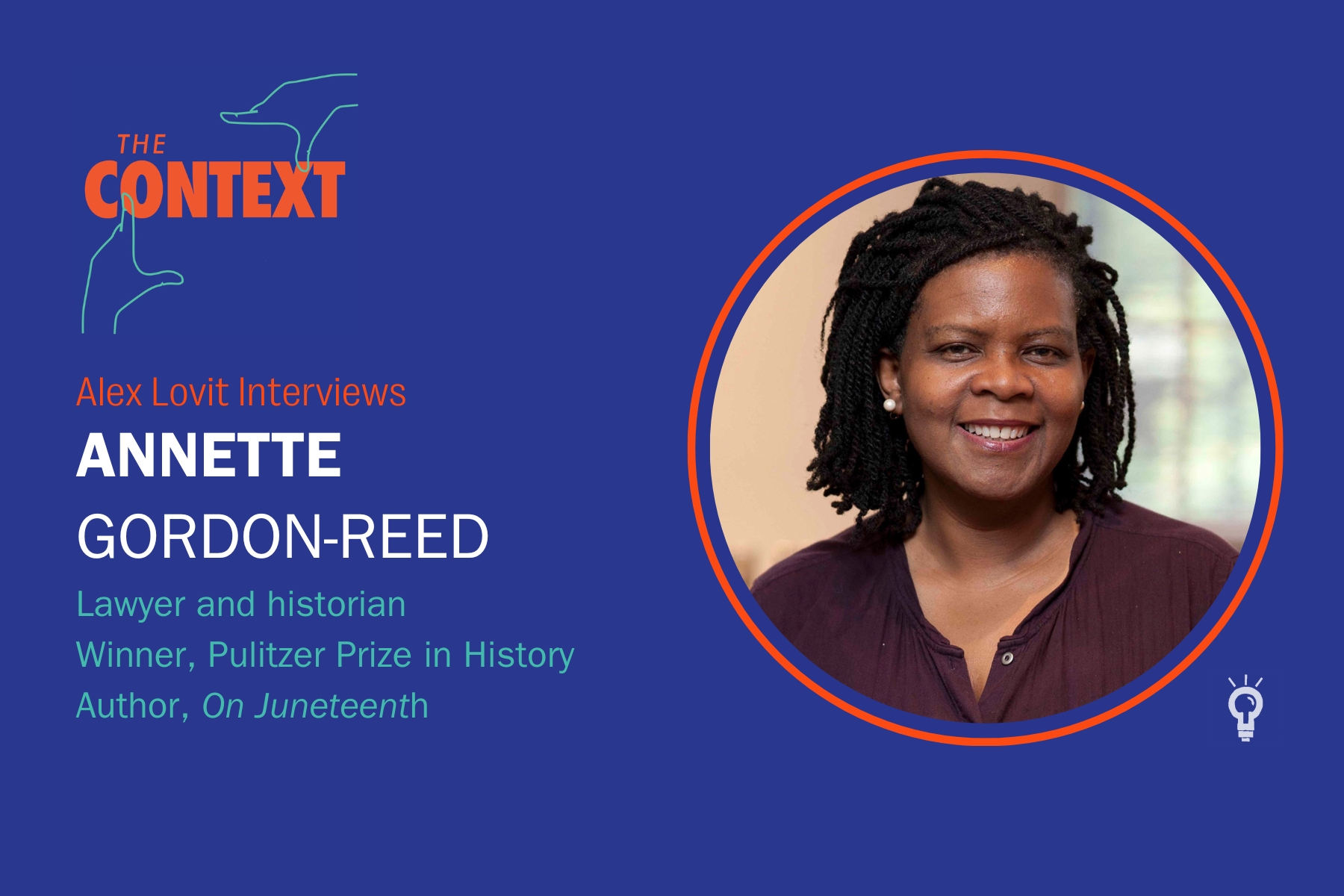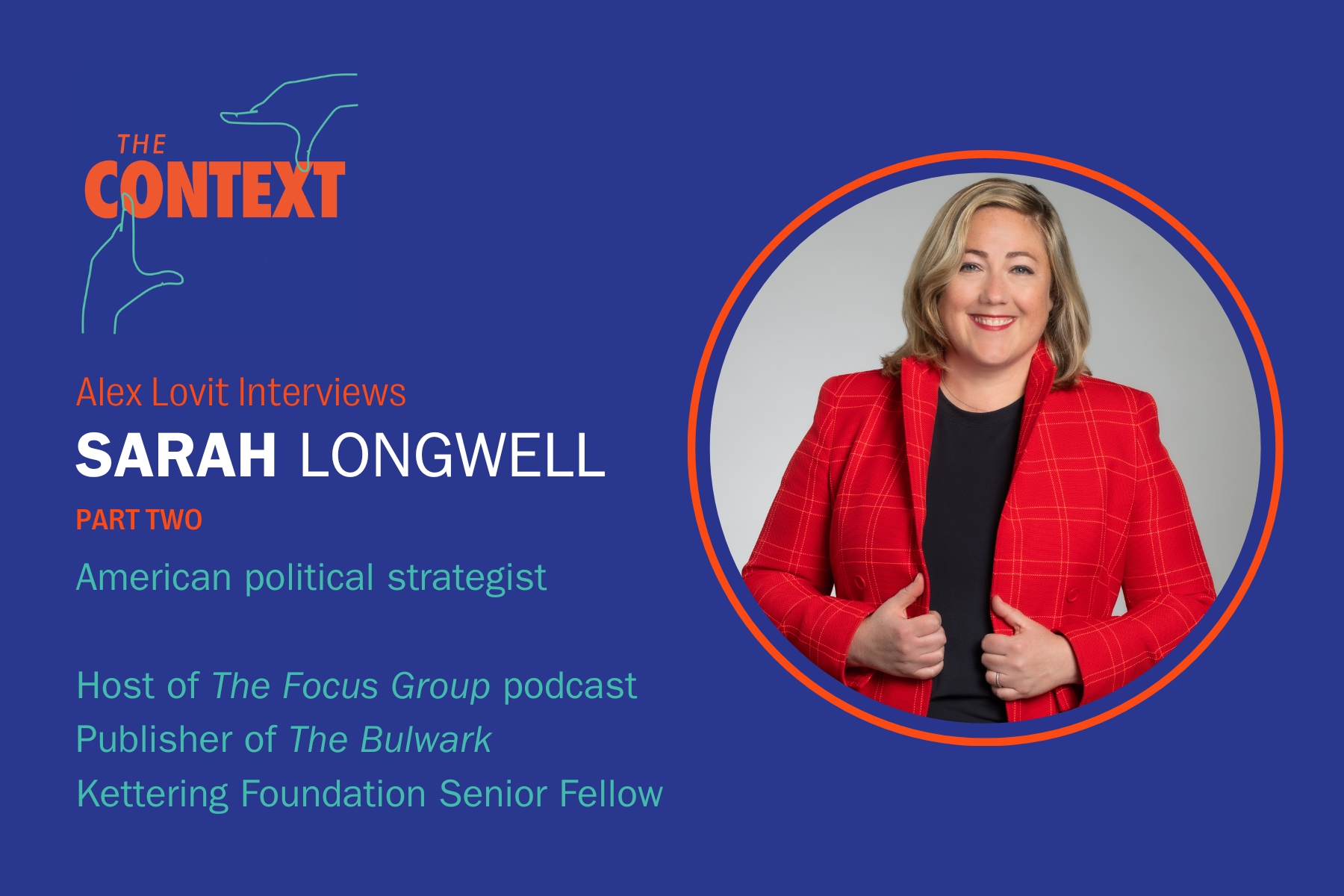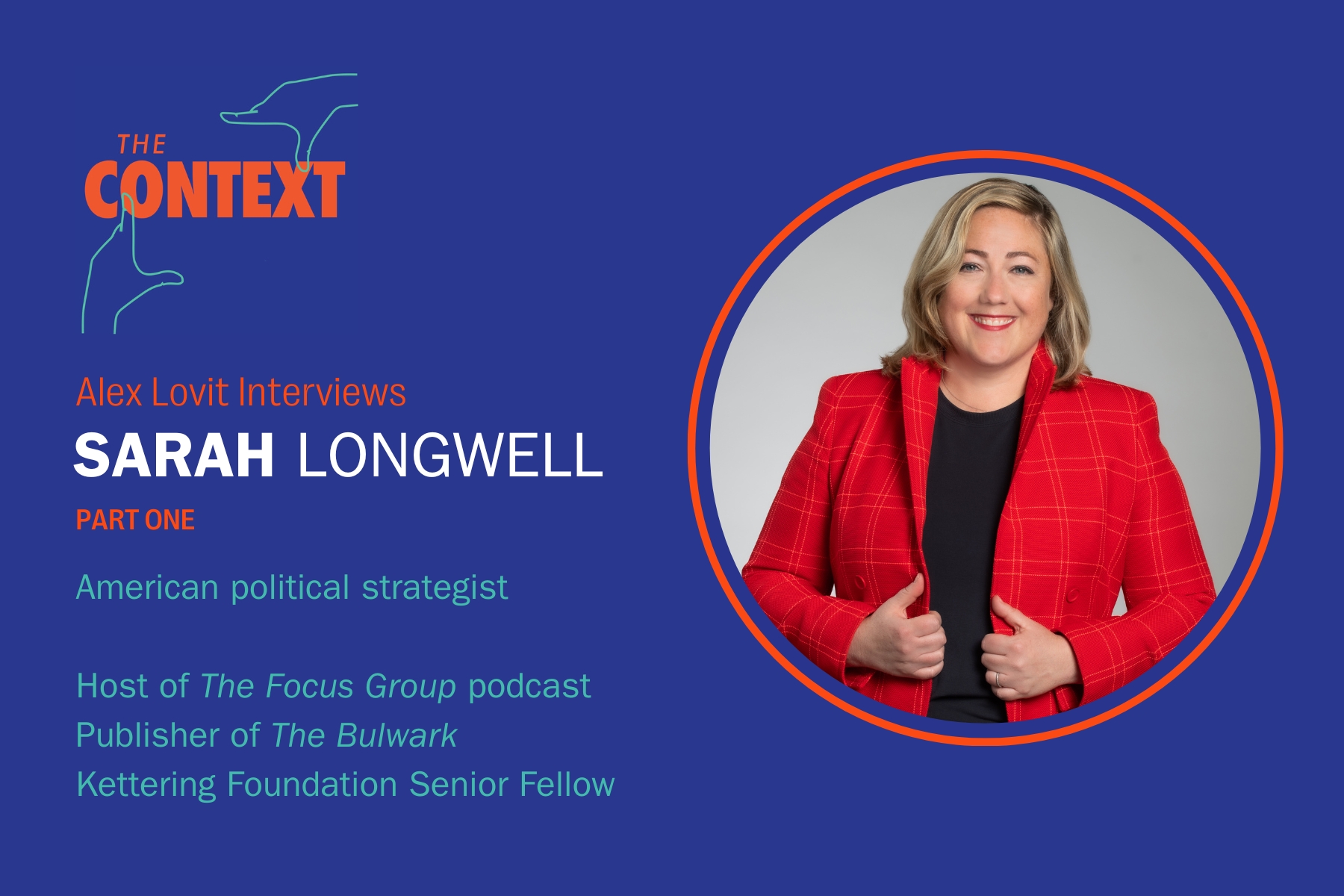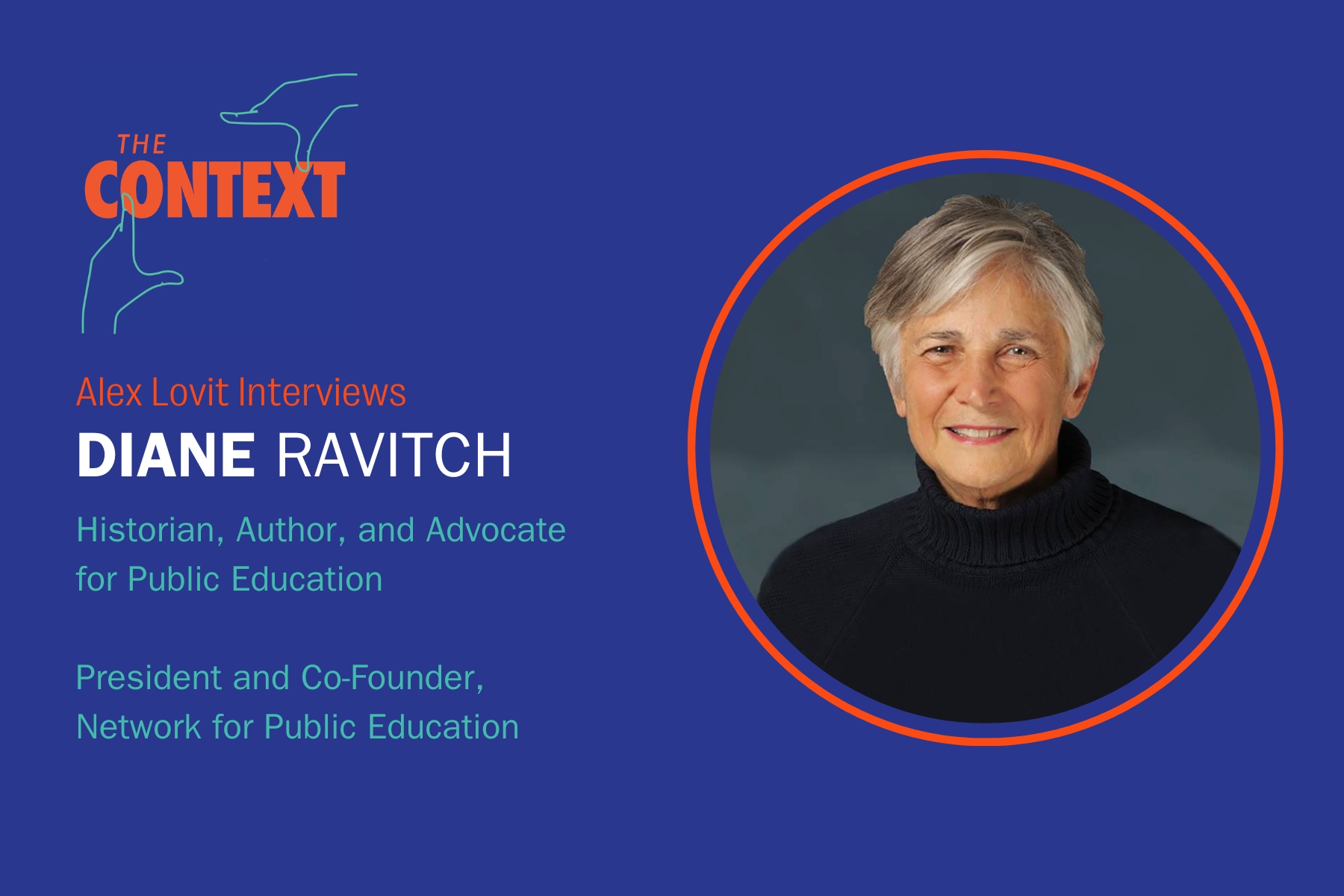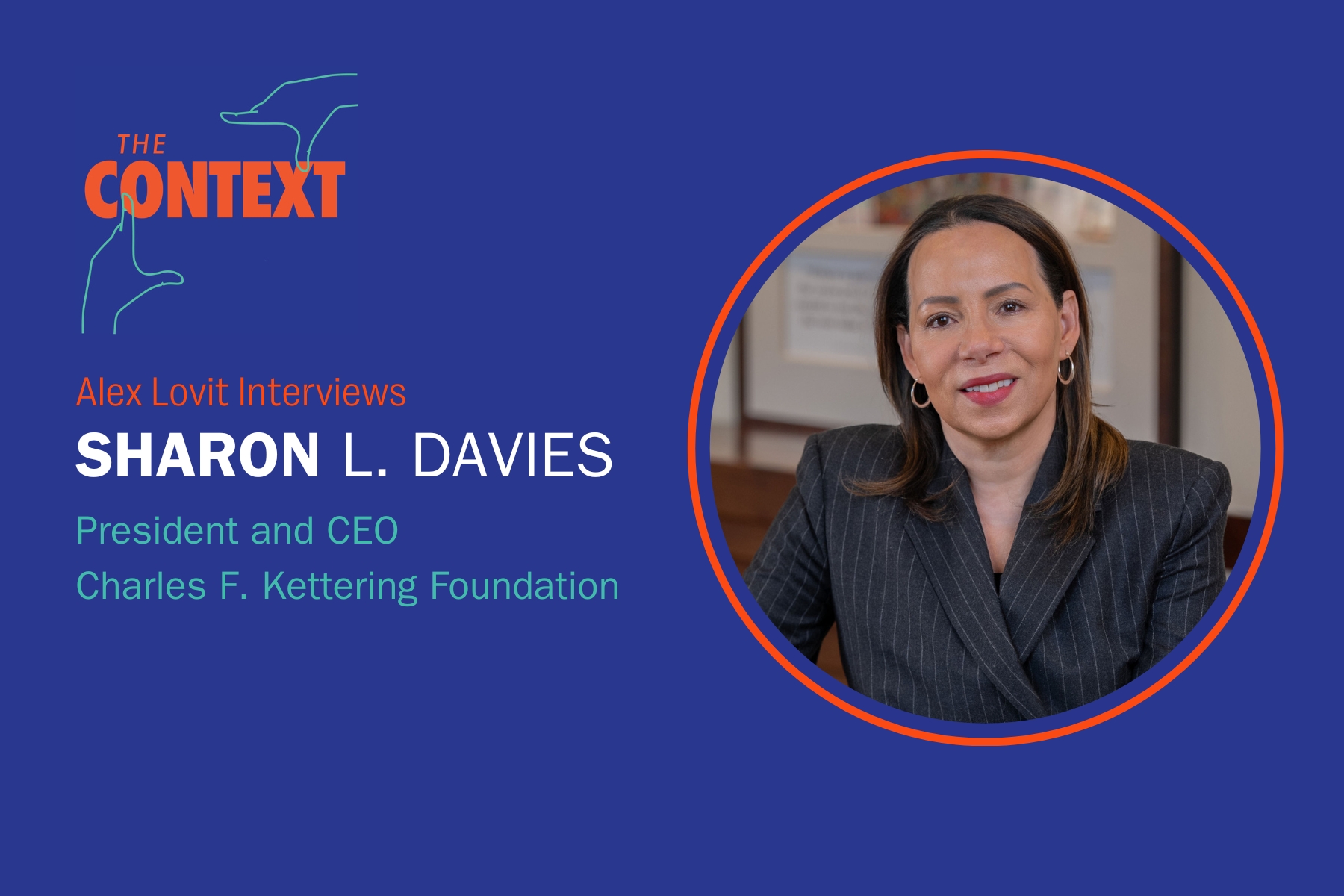Citizens Can End Gerrymandering
A devoted public servant, Maureen O’Connor discusses the importance of efficiency, fairness, and nonpartisanship in government. After years of witnessing and ruling against partisan gerrymandering on the Ohio Supreme Court, O’Connor is working toward an Ohio constitutional amendment to create an independent redistricting commission that empowers citizens, not politicians, to create district lines. Maureen O’Connor is the longest-serving statewide elected woman in Ohio history.
O’Connor was elected to the Ohio Supreme Court in 2003, and in 2011, she became the state’s first female Chief Justice. During her tenure on the court, she led significant reforms and improvements in the Ohio judicial system. In retirement, she is spearheading the campaign Citizens Not Politicians to pass a constitutional amendment to reform redistricting in Ohio, which is slated for the November 2024 ballot. She also serves as a senior fellow for the Charles F. Kettering Foundation.
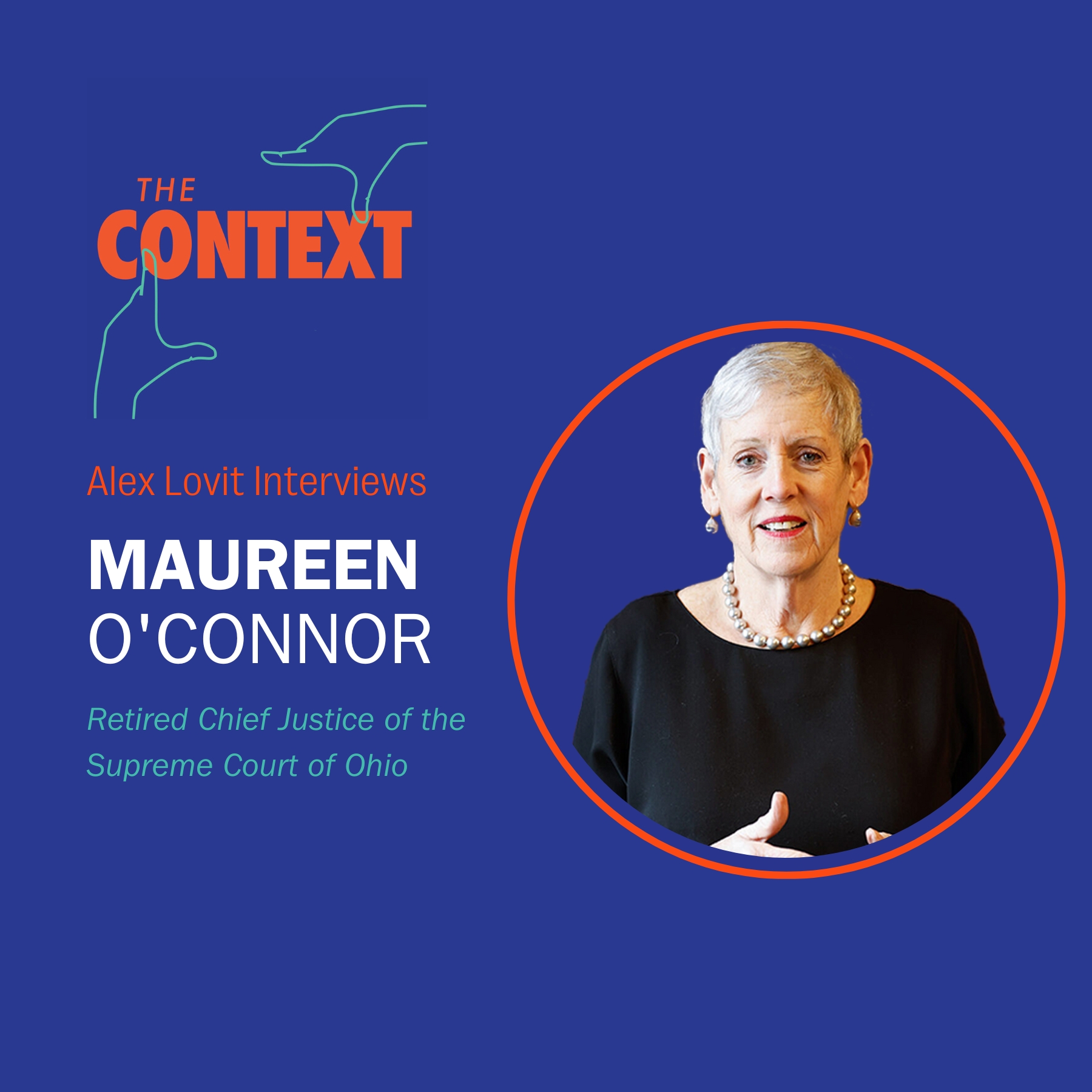
Share Episode
Citizens Can End Gerrymandering
Listen & Subscribe
A devoted public servant, Maureen O’Connor discusses the importance of efficiency, fairness, and nonpartisanship in government. After years of witnessing and ruling against partisan gerrymandering on the Ohio Supreme Court, O’Connor is working toward an Ohio constitutional amendment to create an independent redistricting commission that empowers citizens, not politicians, to create district lines. Maureen O’Connor is the longest-serving statewide elected woman in Ohio history.
O’Connor was elected to the Ohio Supreme Court in 2003, and in 2011, she became the state’s first female Chief Justice. During her tenure on the court, she led significant reforms and improvements in the Ohio judicial system. In retirement, she is spearheading the campaign Citizens Not Politicians to pass a constitutional amendment to reform redistricting in Ohio, which is slated for the November 2024 ballot. She also serves as a senior fellow for the Charles F. Kettering Foundation.

Share Episode
Citizens Can End Gerrymandering
Listen & Subscribe
A devoted public servant, Maureen O’Connor discusses the importance of efficiency, fairness, and nonpartisanship in government. After years of witnessing and ruling against partisan gerrymandering on the Ohio Supreme Court, O’Connor is working toward an Ohio constitutional amendment to create an independent redistricting commission that empowers citizens, not politicians, to create district lines. Maureen O’Connor is the longest-serving statewide elected woman in Ohio history.
O’Connor was elected to the Ohio Supreme Court in 2003, and in 2011, she became the state’s first female Chief Justice. During her tenure on the court, she led significant reforms and improvements in the Ohio judicial system. In retirement, she is spearheading the campaign Citizens Not Politicians to pass a constitutional amendment to reform redistricting in Ohio, which is slated for the November 2024 ballot. She also serves as a senior fellow for the Charles F. Kettering Foundation.
Alex Lovit: Welcome to The Context, a podcast about the past, present, and future of democracy from the Charles F. Kettering Foundation. I’m your host, Alex Lovit. My guest today is Maureen O’Connor. O’Connor has spent a long career serving in the Ohio judiciary, culminating in two decades on the Ohio Supreme Court, including 12 years as Chief Justice. She is the longest serving woman to be elected to statewide office in Ohio history.
She’s currently spearheading an anti-gerrymandering campaign in the state. And she’s also a senior fellow for the Kettering Foundation. The Kettering Foundation’s main campus is located in Dayton, Ohio, and most of the staff, including myself, live in Ohio. So that’s part of why we’re particularly interested in the politics and governance of the state. And Maureen O’Connor has spent decades trying to shape public institutions in Ohio to make them more efficient, fair, and democratically accountable.
As you’ll hear, she’s worked on everything from consistency in sentencing to bail reform, to making it easier to renew license plates. This sort of work isn’t glamorous, but it makes O’Connor a true public servant. Ohio’s been lucky to have her working hard to make state government function effectively. Now I know you may not live in the Buckeye State, but don’t tune out. The issues that O’Connor is drawing attention to are relevant to all Americans and really to anyone who cares about democratic government that is both representative and efficient.
As I mentioned, one issue that currently has O’Connor’s attention is gerrymandering. She’s working with an organization called Citizens Not Politicians to create a new redistricting process in Ohio. The Independent Redistricting Commission O’Connor is proposing would increase transparency and prevent politicians from drawing districts for their own interests or for those of their political party.
One quick note: This conversation includes a reference to the Colorado Supreme Court decision about whether Trump should be removed from the ballot in that state, but we recorded this before that decision was overturned by the U.S. Supreme Court.
Maureen O’Connor, welcome to The Context.
Justice Maureen O’Connor: Well, thank you, and thank you for the invitation.
Alex Lovit: You’ve spent most of your career in the judiciary, culminating in two decades on the Ohio Supreme Court. Different states have different methods of filling judicial openings, but in Ohio we mostly elect our judges. And since 2021, candidates for the State Supreme Court and District Court of Appeals are labeled on the ballot with partisan identification.
Some people argue that partisan elections for positions on the bench increase democratic accountability since voters get a better sense of candidates’ values. Others claim that the judiciary shouldn’t be seen as a partisan institution, or that it’s better to appoint judges than to ask voters to scrutinize unfamiliar names. How do you think about these questions? What’s the best way to get fair-minded judges on the bench who are accountable to the public will?
Justice Maureen O’Connor: One of the things that you mentioned that I am not pleased with, I guess is the way to say it, and advocated against was labeling candidates for the Ohio Supreme Court and our appellate courts—we have 12 appellate districts—labeling them an R or a D on the general ballot. And as I’ve said so many times when speaking about this over the years, when people say, well, why don’t we have R and D that will give us some information, that will give us the ability to vote for the candidate we want to vote for?
And I say an R or a D gives you a cue, but it’s a miscue because if you believe that politics and judges’ political affiliation should make a difference in how they do their job and how they approach interpreting the constitution or the laws in the state of Ohio or sentence someone or all the myriad things that a judge does, then you have misperception of the role of the judiciary. And if a candidate believes that, they don’t deserve to wear the robe because politics should not enter in how a judge does their job anymore than their social club affiliation or their religious affiliation or things along those lines.
You take an oath as a judge not to let any of that influence how you do your job. So I think it’s wrong. I think it’s wrong, and it sends the wrong message to the public.
Alex Lovit: So it sounds like you’re definitely opposed to partisan election for judges. Do you have any thoughts on electing judges versus having judges appointed by elected officials?
Justice Maureen O’Connor: There’s no perfect way to select a judge. Whether you’re selecting a justice for the Supreme Court of the United States or whether you’re appointing a municipal judge or electing a municipal judge here in Ohio, there’s no perfect way. Politics enters into the decision-making both if it’s an appointed system and the elected official make a decision that way. You’re going to look at the politics of the appointing authorities, and that could be problematic.
I will tell you that in the late ‘30s and the late ‘80s—so 50 years apart—the question was put to Ohio voters, shall we appoint our judiciary, in other words, abandon the elected system that we have? Resoundingly defeated two to one, maybe even more than that. Both elections, again, 50 years apart, Ohioans want to elect their judges. That’s embedded in their perception of their voting rights.
Alex Lovit: Another issue, kind of general issue for the judiciary, is discretion for issues like sentencing. On the one hand, consistency is important for justice. Ideally, outcomes shouldn’t vary too much depending on which judge is overseeing a trial. On the other hand, the judge overseeing any particular case has the closest perspective on the people and the facts involved. How do you think about the balance between judicial discretion and consistency?
Justice Maureen O’Connor: I will admit here in Ohio we have pretty broad parameters when it comes to a sentence for many of our crimes. So it’s up to the judge. And the way it’s reviewed is, is this sentence within the parameters of the law? In other words, if someone could get four, five, six, seven, eight years, and that’s the way that the statute reads, and a judge gives eight years, you know, the maximum sentence, there’s, I would hope, on the record the reason for maxing out, as they say, someone to a sentence.
And the judge obviously has the ability to do the minimum as well or somewhere in between. We have in Ohio mandatory minimums and that sort of thing. So judges don’t have total discretion when it comes to sentencing. For example, they couldn’t put someone on probation when there was a mandatory minimum sentence for the offense and the conviction. But we, over the last several years in Ohio, have an initiative that would allow for the sentences to be placed in a databank, and they could be analyzed. And the disparities, the varieties, et cetera of the sentences would be made available.
It’s important to note that this data, this information, is anonymized. So it’s not related to one particular judge and how they do their sentencing. But it would be a searchable database so you could determine what’s the average sentence in Ohio. What do most judges sentence an individual to for this particular offense with this particular background? It would be very specific given the race of the individual, the age of the individual, the education of the individual, the status of the victims. All that information gets placed in a data system, and it can be researched.
The purpose is then judges will be informed as to what the majority of the judges in this state, how they handle the cases, and that would promote consistency in sentencing. And if some judge is consistently an outlier, it would really, I would hope, cause that judge to pause and think and evaluate what they’re doing. The other thing, there’re always accusations the judges sentence according to race or there’s some other inappropriate or impermissible reason that enters into it.
And how do you combat that? If you don’t have the data to rely upon, how are you going to combat the misinformation about sentencing? It’s a little bit of a tough sell to some judges to do this. As you mentioned, starting [now], judges are elected. They’re fearful that their records will be scrutinized in a way that maybe they don’t want to say they don’t understand what this database is about. So their initial reaction to some judges is no, I’m not going to participate. I don’t want anything to do with this.
Alex Lovit: You’re talking about the sentencing databank that was an initiative that you spearheaded while you were on the Supreme Court. And there are a number of initiatives that you were involved in to make the court system both more efficient and, in that case, fairer, including bail reform, expanding remote technology during the COVID pandemic. These sorts of things take real work and they rarely make headlines, but they do help to build a justice system that serves the public. What motivated you to engage in this work?
Justice Maureen O’Connor: It’s how I view my job as Chief Justice, which you just mentioned, and additional things that I’ve done are necessary to improve our judicial system. And we are public servants. We start out with that premise. And it’s true—we are public servants. There’s no reason for us to exist if we don’t serve the public. Society’s problems are brought to court, and we are the problem solvers, and we solve problems for people.
I always say that people come to court—they don’t want to be in court, but they come to court because they are facing problems that they cannot solve for themselves. No matter what the problem might be, it requires the intervention or the involvement of our court system. So we have to make the court system as efficient and as fair and as public servant-minded as it can be. And when I look at things—like you mentioned bail reform. Bail started out in this society as a means for people to get out of jail pending the resolution of their case. It was not a means to keep them in.
It has morphed over the years into a means to keep people in jail. That’s not appropriate. As I said, it should be a means for people to be released from custody but to have the bail that will ensure their return to face their charges. And that has to be commensurate with their means. And so many times a really high bail would be set and, in reality, given the nature of the offense, the nature of the victim, the continuing criminal conduct of the individual, the law would allow for no bail.
But judges instead do these grandiose three-million-dollar bails, I’m going to keep you in jail, that sort of thing. In reality, I think that hurts the perception of the use of bail. I do, and I don’t agree with those types of bail. But let’s looks realistically at the purpose. Let’s look at the means we have to achieve that purpose. And then let’s look at how we can do that by being fair to the person in custody, the defendant, but also mindful of public safety. So that’s what a judge has to do.
Alex Lovit: State Supreme Courts sometimes have to make decisions that receive national attention and which might affect the results of elections. In these cases, judges can experience a lot of political pressure. You’ve experienced this yourself. Recently, the Colorado Supreme Court ruled that Donald Trump should be excluded from the primary and general election ballots in that state due to the 14th Amendment’s ban on federal officers who engaged in insurrection. Maine has a different system, so it was the Secretary of State that made that decision in that state.
How should judges or other officials approach these high-profile, politically charged decisions?
Justice Maureen O’Connor: I think that they have to approach those decisions the same way they approach all decisions. You seek to be fair. You look at the law. You certainly pay close attention to the arguments that are being proffered by both sides. There’ll be a briefing. The research that’s necessary has to be done. And then the judge has to make a decision. And that judge’s decision cannot be influenced by their own personal politics or by any other pressure that might be out there.
And when I say that, I’m saying media pressure. The media are all over Colorado and Maine and maybe others that might be challenging out there. The media have to be careful, and I would love to see the media being responsible. But that’s too much to ask sometimes, and I don’t expect it to happen in this instance. But the judge or judges when it comes to a Supreme Court, it’s important, as I said, to be prepared, to know the law, to know the arguments, to confer with colleagues on the bench as part of your job, and then to issue a well-reasoned written opinion that is solid.
And don’t be concerned about the criticism that is going to come from one side or the other. That’s inevitable, especially in these high-profile cases such as that involving the primaries for Donald Trump. And the political pressure, as I said, political, media, you name it, people are going to be opining on how the judges should rule, how the system should work, and what the outcome should be. You’ve got to turn that all off. You’ve got to do your job. That’s all—just do your jobs.
Now having said that, it’s extremely important to be aware and to talk with, for example, security people in your court, people that are responsible for keeping judges safe, about what needs to be changed in order to feel safe in doing your job.
Alex Lovit: Proposed amendments to Ohio State Constitution have received a lot of attention recently. Talking about the media, including national media, last year saw an August proposal to make it harder to amend the Constitution, which was defeated. And then in November there were two successful amendments to legalize both abortion and cannabis. But now you’re proposing a redistricting amendment for this year, 2024, which we’ll talk about in a moment.
In Ohio, amendments to the State Constitution can either be proposed by the State Legislature or through petitions with sufficient signatures from Ohio citizens. And in either case, they then go to a statewide vote. But there’s a lot of variation between the states and how state constitutions can be amended. Less than half of states have a system like Ohio for citizens to propose amendments. Do you think Ohio system works well?
Justice Maureen O’Connor: I feel so fortunate to have the system that we have in Ohio that allows for citizens’ initiative. Now there’s one correction in what you mentioned there. The cannabis was not a Constitutional amendment. That was a statute. And Ohio has the ability for citizens to do both citizen initiative statutes and Constitutional amendments. The reproductive rights was a constitutional amendment. The cannabis was a statute. But they were both passed by the citizens.
We are so fortunate in Ohio to have this recognition that all power resides with the people. And as such, people have the ability when they see their legislature being unresponsive to the will of the people, the majority of the people, they have this ability to put these questions then before the people. The results then will be either embedded in the Constitution or a new statute. And we’re blessed to have that ability, and I’m very grateful.
Alex Lovit: The rest of my conversation with Justice Maureen O’Connor focuses on redistricting. But this topic can get pretty technical. So before we dive deeper, let’s do a little gerrymandering 101. Almost all elected officials in the U.S. represent some specific geographic district. Since populations shift over time, those districts need to shift as well to ensure that everyone has equal representation. So if one region’s population grows while another one shrinks, we have to redraw the lines to make sure that each state legislative and U.S. House district has approximately the same population.
Normally, states do this every ten years after each national census. The problem is that it’s possible to draw these district lines to minimize or maximize the voting power of particular groups or to benefit one of our two major parties. That’s what we call gerrymandering. The basic strategy of gerrymandering is to force your opponents to waste votes so they win districts by larger than necessary margins while others remain out of reach.
Gerrymandering distorts representation, leading to legislatures where the partisan breakdown doesn’t align with the parties’ popular support among the voters. And because it insulates elected officials from cross-party competition, it also leads to more extreme representatives. And for voters in districts that have been designed to be noncompetitive, it’s frustrating and alienating. In short, gerrymandering is bad for democracy.
In Ohio, this all came to a head in 2022 when the state had to draw new districts for that year’s election. Under the current Ohio Constitution, redistricting is determined by a commission, which is supposed to draw districts complying with certain guidelines, including—and I’m quote the State Constitution here, “The statewide proportion of districts whose voters favor each political party shall correspond closely to the statewide preferences of the voters of Ohio.”
In 2022, statewide elections over the previous decade had averaged a 54 percent vote share for the republican party and 46 for the democratic party. But the Redistricting Commission, which had a republic a majority, proposed maps where republicans had the advantage in significantly more than 54 percent of the districts. So the Ohio Supreme Court, with Maureen O’Connor as the crucial swing vote, invalidated the maps and sent them back to the Commission.
That actually happened five times. The Redistricting Commission kept proposing maps, and the State Supreme Court kept rejecting them for violating the section of the Ohio Constitution I just quoted. But in the end, in May of 2002, a Federal Court intervened, saying that that year’s election was getting too close for continued litigation over redistricting. The Federal Court imposed one of the Commission’s maps, which the State Supreme Court had previously declared unconstitutional.
And in the 2022 elections, republicans won 68 percent of the seats in both the Ohio House and in state’s delegation to the Federal House of Representatives, and 79 percent of the seats in the Ohio Senate, a far cry from the 54-46 split the State Supreme Court was looking for. This is why O’Connor is pushing for a new amendment to create an independent Redistricting Commission in Ohio. Let’s get back to the interview.
Alex Lovit: The word gerrymandering dates back to 1812. And one response to the history of gerrymandering might be to say, well, this has been a problem for over two centuries of American history. It’s always been a problem; it always will be a problem. Why should we be focusing on this in 2024? What’s your response to that?
Justice Maureen O’Connor: It can be fixed. We can have a solution here. And that’s what the Constitutional amendment that we’re working on right now, that right now signatures are being gathered to place it on the ballot in November of ‘24. And how is this going to change things? It’s the reconfiguration of what the Redistricting Commission looks like. The name of our effort, our group, is called Citizens Not Politicians. The beauty of having the citizens—the power lies with citizens. And this Constitutional amendment will recognize that and bring citizens into the participation of how the districts are drawn.
The big distinction is that there will be a Redistricting Commission that is made up of 15 members, not the seven members that we have now. All those seven members are elected political actors, both democrat and republican. Majority five republicans, two democrats. Doesn’t matter if they’re D’s or R’s. They’re all political actors. And the new proposal is that we’ll be 15 members. There’ll be five members who are registered democrats, five members who are registered republicans, and five members who are registered to vote but are neither party.
So they will be considered the independents because they are neither republican nor democrat. And that will comprise the Redistricting Commission. And they are charged with drawing maps, and they are charged with the new Constitutional amendment, [has] things that must be taken into consideration when drawing those maps. For the citizens, the important thing to realize is that there will be hearings by this 15-member board throughout the state before the maps are drawn.
So they will listen to the public, and they will be in all five different areas of the state, all the four quadrants around the northeast, southeast, southwest, and central Ohio, and citizens and people who are interested in [why] they think a district should look or [what] their community should be kept together. One of the factors is try to keep together, if at all possible, communities of interest. And those people who believe they’re a community of interest will be able to plead their case to this Redistricting Commission on why it’s so important they be kept in the same district and not have their vote diluted.
And that’s basically what gerrymandering does right now is dilute votes. They will take a concentration of—and I’m just using this for example—urban voters that tend to vote for democratic candidates and issues, and they will divide it so that the vote is diluted because the districts have the majority of a very conservative voting membership and a small part of the urban district. And that becomes one district. And obviously, the more progressive voters, a vote is diluted. They will never prevail. They will never then have a member of the legislature that reflects their vote, their needs, their community of interest.
So again, it’s important to have communities of interest kept together. And that does not necessarily mean just urban areas. There’re other areas of communities of interest. One of the things that we put in the Constitution for—by way of example, school districts could be communities of interest, that school districts should be kept together in one district, one House or Senate district for unique purposes. So that’s basically why we need the Constitutional amendment.
Alex Lovit: So as you previously mentioned, the Commission will consist of five democrats, five republicans, and five independents. Can you talk a little bit about the protections in this amendment to ensure that the independents are truly independent?
Justice Maureen O’Connor: Yes. And it’s not only ensure that independents are truly independent but the democrats and the republicans are truly nonactive registered republicans or democrats. In other words, they can’t be elected. They can’t be on somebody’s committee to elect them. They can’t be someone who goes out and puts up signs and does literature for the party because that suggests that you are active in a particular party, whether it’s D or R.
So there’s going to be an application process, as I said. There’s going to be a weeding out. I’m presuming that we’re going to get a lot of applications, and I hope we do. I know we will. And there will be four retired judges to identify the people who would be on the Commission. And they will be assisted by a vendor who will do background checks on the people that are—once it gets down to a certain number of individuals to be considered, they’ll have to make sure they are who they say there are and free of any reason that they shouldn’t be on the Commission.
And as I said, there’s a list of them in the amendment. And that not only they but their immediate family are not involved in this highly partisan environment. And the same goes true then for the people who are of neither party. You know, the word independent is being used—five R’s, five D’s, and five independents. It’s really five people who are members of neither party. And that means that they haven’t voted in either party’s primary for a certain amount of years.
But that doesn’t mean they couldn’t be registered, for example, with the Green Party or some other minority party that they’re a part of. But they’re independent of the republican and independent of the democratic party. And they would be eligible to be on—one of those five. So they’re vetted and given their oaths. And there will be a staff that will be created to assist them. These are citizens, after all. They’re not going to be tasked with doing the ministerial work of how you put together a commission.
There’ll be an Executive Director position, what in other countries is called like the Secretariat. So they are the support players for the Redistricting Commission. That’ll be a small group of people, but it’s provided for in the Constitution. I should say we should probably look at the funding because that’s going to be one of the things that people are going to talk about: How’s this going to be funded? The criticism will be, oh, this is a blank check for a group of nonelected officials to make these decisions for the state of Ohio and, therefore, there’s no accountability.
And the response is if you read the amendment, there is a cap on what can be spent in this new redistricting configuration, and that cap is linked to exactly what was spent by the old Redistricting Commission, what were their needs, and the legislature. And the new Redistricting Commission cannot exceed what the previous efforts were in the cost. So there is a cap on it. That’s important to note that it’s not an unaccountable, unelected commission because they do have their guideposts. They do have their limits. And they do have the criteria that they have to conform with.
Alex Lovit: Am I correct that there’s not only a cap on the budget but also a floor to prevent the legislature from defunding the Commission?
Justice Maureen O’Connor: Yes. This is a mandatory funding. They have to do this. They have to.
Alex Lovit: There have been some proposals for a Federal redistricting mandate, most prominently the For the People Act, which would require states to establish these independent redistricting commissions and also includes other voting rights protections and campaign finance reforms. That act received majority support in both chambers of the U.S. legislature in 2021 but was blocked by a filibuster in the Senate. Do you support this kind of national level reform?
Justice Maureen O’Connor: I think that it has worked in Michigan. It has worked in other states that have done a variation on getting politicians out of the process of redistricting. And so I think Ohio’s going to be the big example of the success of citizens accepting this, and then the map drawing taking place and fair and impartial districts being drawn. And we’ll see what happens in Ohio. But I think all eyes are on Ohio to see if it’s going to work in Ohio, in other words, if the citizens are going to pass this Constitutional amendment. It’s going to be implemented, and there’re going to be fair districts.
And as a result, we’re going to see a legislature that reflects and will be responsive to the interests of the voters. It will pass in Ohio, and I think that we will become that poster child for the national effort. I’m not sure—I haven’t examined about whether the Federal government can dictate that to the individual states. I’ve never researched that. I’ve never read anything on Congress’s authority to do that for state elections. So I don’t know.
Alex Lovit: But you’re saying that the state efforts can be allies in the national efforts rather than [seeing those things] as opposed to each other.
Justice Maureen O’Connor: Yes. Absolutely.
Alex Lovit: Some argue that there’s kind of this stalemate where blue states are mostly gerrymandered for the democratic party and red states are mostly gerrymandered for the republican party, and neither side can afford to unilaterally disarm. What would you say to an Ohio republican who says, “Yeah, our current system isn’t exactly fair, but we need to balance out the democratic gerrymander in Maryland”?
Justice Maureen O’Connor: I’d say no, we don’t [laughs]. Who says we have to do that? I mean, we’ve got to balance out? No. Let’s have everybody do a fair system of selecting the members for their House and Senate, legislature in their states, and the [congressionals]. Again, we can’t help but have an improved system. I mean, [laughs] look at the people and look at the way it’s been operating over the last years in Washington. We can’t help but have a better system than what we’ve got.
And so there is no rationale that, oh, we’ve got to balance out Maryland, and we’ve got to balance out New York. There’s no mandate that we have to be gerrymandered in our state so that we can be in the republican or the democratic column. You let the chips fall where they may. And that’s what this whole process is, isn’t it? Elections are let the chips fall where they may and do it fairly. And that’s all we ask. And that’s all the public wants.
Alex Lovit: You’ve been affiliated with the Republican Party throughout your career, but you’ve recently faced criticism from the Ohio GOP over this redistricting issue. You’ve also been critical of Donald Trump. What is your current relationship with the Republican Party, and do you think that some in the party aren’t letting the chips fall where they may or prioritizing partisan advantage of principles of democratic accountability?
Justice Maureen O’Connor: Your last part of that question, I think obviously there are—the concept of let the chips fall where they may and let’s have fair and equal districts, and let’s do the will of the people, it’s been demonstrated time and time again that that’s not the motivation of the majority of the members of our legislature and the leadership—the republican leadership in Ohio. That’s just a fact. Now my relationship with the Republican Party—I’m a registered republican. I’m not a Donald Trump republican. I never could be or would be. I am a moderate republican who sees social justice as being one of the obligations we as a society must have.
And I don’t care whether you’re a D or an R or an independent. People have to embrace social justice and the recognition of the shortcomings in our system and how we can fix it and how we do it because we’re public servants, and we’re there to make the existence of the public better in any way that we can. And that includes inserting fairness and nonpartisan interest in every effort that we can in order to better things for the citizens of Ohio.
Citizens of Ohio don’t care whether, for example, a republican or a democrat runs the Bureau of Motor Vehicles. Let me give you an example. There’s a system called Old Plates, if you’ve used that to renew your license plates, right? It’s so easy to do. It’s not time-consuming. And it saves on both manpower at the Bureau of Motor Vehicles, and it allows the citizen to do it, get it over with, and you’re going to get your sticker in the mail. What could be easier?
Does anybody care if that’s a republican or democrat administration that came up with that? I will tell you that that happened when I was Public Safety Director and Bureau of Motor Vehicles was one of my divisions, and this is something that I pushed to have. Now again, it’s not an R or a D thing. It’s good government. Isn’t that what everybody wants? They want good government. They don’t want the legislature to dictate, but where it’s appropriate for the legislature to enact laws, that those laws be fair and take into consideration the interest that needed to be taken into consideration before the laws were made.
Alex Lovit: So I have used Old Plates. I didn’t know I had you to thank for that. So thank you for it.
Justice Maureen O’Connor: [Laughs]
Alex Lovit: It is an efficient system.
Justice Maureen O’Connor: It’s great.
Alex Lovit: So for listeners in Ohio, what can they do to support this amendment? And for listeners outside of Ohio who may be concerned about these issues of redistricting and gerrymandering, do you have any general advice for what they can do to promote a fairer system?
Justice Maureen O’Connor: Citizens of Ohio, there’re several things I would recommend. Please register to vote and exercise your vote and do it consistently and do it in the primaries and do it in the general election. Be registered to vote. And then over the next couple of months, when you are presented with a petition to sign so that the Constitutional amendment that I’m speaking of can get on the ballot in November of ‘24. We have to have over 413,000 valid signatures from citizens who are registered to vote, and they have to be presented by July—the beginning of July. And those votes will be tallied, and they will be examined to make sure that whoever signed it is a registered voter in Ohio.
And if the number is hit, then the ballot will contain this Constitutional amendment. So the challenge right now is to get those signatures on the petition. And there are volunteers, and there are also paid signature collectors who are out there at various locations—they will be even during the winter—trying to get these signatures on the petition. So if you’re a registered voter and you’re asked to sign a petition, please just sign the petition so we can get this on the ballot so people can vote on it.
What would I recommend to other states? I think the states that have the beauty of a citizen’s initiative, I would say use your citizen’s initiative. Investigate what it is and see what you can do to create a citizen’s initiative for a Constitutional amendment in your state. Unfortunately, there are states that don’t have this. In fact, the majority of the states don’t have the ability to do a citizen’s initiative for either a statute or for a Constitutional amendment.
Their challenge then is to organize outside of the ability to do this and to influence their legislators when it comes to drawing maps but also to be very mindful of their district elections and be mindful of the people who are running. If you’re in a gerrymandered district in these states that don’t have the Constitutional initiative ability and there is a primary, look closely at your candidates there, and make sure you don’t for the extremist, that you vote for the moderate republican or the moderate democrat.
This goes both ways. This isn’t just republican. You know, the advice and what I’m talking about applies to democrats as well. For example, this map—the most recent map that came out was challenged as being unconstitutional. But it was signed, approved by all seven members of the Commission, including the two democratic members. Again, there’s no independent thought that democrats haven’t cornered the market on that. There’s politics involved in what they do as well.
If your district’s safe and the districts of your friends are safe, yeah, okay, you’ll vote on that map. Again, that’s not what it’s supposed to be.
Alex Lovit: Well, thank you for that advice for citizens all across the country, all of whom are dealing with this problem. And thank you for your extensive service to make the judiciary and Ohio government work better for its citizens. And finally, thank you for joining me on The Context.
Justice Maureen O’Connor: Thank you. It’s my pleasure.
Alex Lovit: The Context is a production of the Charles F. Kettering Foundation. The opinions expressed in this program do not necessarily reflect the views of the Kettering Foundation, its directors, or its officers. I’m Alex Lovit, a Senior Program Officer and Historian with the Foundation. Research assistance provided by Isabel Pergande, episode production by George Drake, Jr. Kettering’s Director of Communications is Melinda Gilmore.
To connect with the show, please email The Context at Kettering.org. To subscribe to Kettering’s e-newsletter, visit Kettering.org. If you enjoyed this episode, don’t forget to subscribe and leave a review or tell a friend about the show. We’ll be back in this feed with more conversations about democracy in a couple of weeks.
Transcripts are created on a rush deadline by a Kettering Foundation contractor and may contain small errors. The authoritative record is the audio recording.
More Episodes
- Published On: June 17, 2025
Juneteenth commemorates the end of slavery in the United States. Pulitzer Prize-winning historian Annette Gordon-Reed joins host Alex Lovit to discuss Juneteenth’s...
- Published On: June 3, 2025
Who should make decisions about what kinds of health care American minors can receive: their parents and doctors, or their state governments?...
- Published On: May 27, 2025
Pro-democracy progressives are their own worst enemy when it comes to recruiting conservative Americans to their cause. In part two of our...
- Published On: May 20, 2025
How did one of our major political parties abandon its principles? And what do voters make of that shift? Host Alex Lovit...
- Published On: May 6, 2025
Public schools are essential for democracy—and they’re under attack. But the very policies that are being championed as their salvation may have...
- Published On: April 22, 2025
US institutions are being pressured into compliance with the Trump administration’s capricious demands. Many law firms, philanthropic organizations, and higher education institutions...
